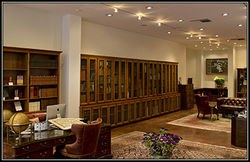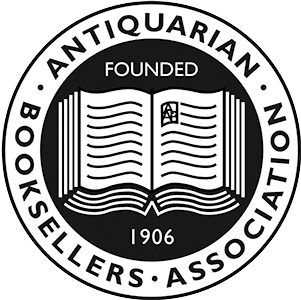London: Printed by John Haviland, for Thomas Alchorn, 1638. LOCKE, John; TYMME, Thomas. From the Library of John Locke
[LOCKE, John, association]. TYMME, Thomas. A Silver Watch Bell, The Sound whereof is able (by the Grace of God) to win the most prophane Worldling and careless Liver, (if there be but the least spark of Grace remaining in him) to become a true Christian indeed, that in the end he may obtain everlasting Salvation; Whereunto is adjoyned, A Treatise of the Holy Sacrament of The Lord's Supper, in part augmented. By Thomas Tymme. XVIIIth Impression. London: Printed by John Haviland, for Thomas Alchorn, 1638.
Small octavo. [A1], [tipped-in leaf, with title supplied in ink on recto], A3-A8, B-H8, I1, I3-I8, K-T8. [2, blank], [2, title in ink, verso blank], [6, Dedication], [4, To the Reader], [2, Contents], [1]2-114, 117-188 pp. Lacking A2 (title-page) and I2 (pp. 115-116). Text within double-ruled border, with headline, page numbers, and marginal glosses inside outer border. Sixteen head-pieces, fourteen ornamental initials, and two tail-pieces.
Contemporary marbled boards, rebacked (possibly in 1915, according to pencil note on front pastedown) with speckled calf, modern red and white paper spine label lettered in ink. Plain endpapers, all edges speckled red, some trimmed close to headlines and in a few cases to marginal inscriptions. Boards worn, hinges cracked. Tiny rust or ink hole to top of front free endpaper, tiny wormhole to outer margin of beginning leaves, affecting a letter or two of marginal glosses. Over-opened at a few places. Still a very good copy.
A popular, much-reprinted work, Tymme’s little religious book was first published in 1605. This copy contains ink inscriptions, signatures, and marginal notations in at least five different hands: John Locke (dated 1669 on p. v), Ri. Yolland (undated), Emmanual Bayhind (undated), William Yoo (dated December 21, 1782 on p. 244), and Rietteel (dated N. York, 1819 on front free endpaper and title-page). We have been unable to locate any information on the later owners of the book.
While many of the annotations in the volume are by its later owners, pp. iv and v contain Locke’s signatures and inscriptions, including a quotation in Greek. Numerous other pages (pp. 4, 6, 9, 66, 78, 80, 101, 118, 134, 139, 144, 146, 165, 228, 229, 232, 234, and 238) contain marginal notes (often in Greek) in what appears to be the same handwriting. Locke may have noted in the margin of p. 96 the date he purchased the book, its cost, and a selected list of page numbers; though partially obliterated by a later owner, the note seems to read "166[?]...his book of Mr....[?] florins." On p. 176, there appears in the margin a figure which may perhaps be an early, crude version of Locke’s paraph–the distinctive mark he used to authenticate his signature on legal documents, and occasionally to mark his books for an unknown purpose (see Harrison and Laslett, pp. 41-2). Locke may have marked the spine with a label or press-mark, but if so, this has been lost when the volume was rebacked.
During the period that Locke (1632-1704) acquired and annotated this volume, he was a tutor at Christ Church, Oxford. A book collector as well as physician, writer, and scholar, Locke amassed his library primarily for his own research purposes. In 1669, however, he did not have the bulk of the volumes which would comprise his library at Otes in the 1680s and ‘90s. In those later years, Locke was faced with a rapidly expanding library which confounded attempts to find any particular volume in it. Locke therefore developed a complicated cataloguing procedure to allow him easily to locate the volumes he needed. Though he generally made notations for his own reference on the title-page, spine, and last page of a work—and often also made a list of page numbers for future reference on a fly-leaf—he typically did not underline words or phrases in his books. "On the whole he left his margins well alone, and made his notes in his notebooks," always showing "much admirable respect for the whiteness of his pages and the general appearance of the volumes standing in his boxes" (Harrison and Laslett, p. 39).
It is important to remember, though, that Locke’s cataloguing procedures were developed and perfected in the 1680s and 1690s—this was the first period in his life when his books were physically all in the same place: "Books which went out of Locke’s possession in earlier years would have far less and less regular markings—some of them perhaps not marked in any way. But the over-lining and underlining would probably be present, with sometimes the author’s name. A spine label giving author and a digit, indicating size, might also be present....These signs are not unusually found in Otes books which had been with Locke before 1683, and occasionally the two figure press-marks there can be seen to have been converted from the one-figure marks which we believe characterized the books in Christ Church in 1681" (Harrison and Laslett, p. 43). Tymme’s volume, then, is probably one which Locke sold or gave away (possibly to a current or former pupil) before he perfected his cataloguing method.
See Harrison and Laslett, The Library of John Locke(1965).
HBS 66431.
$25,000.









